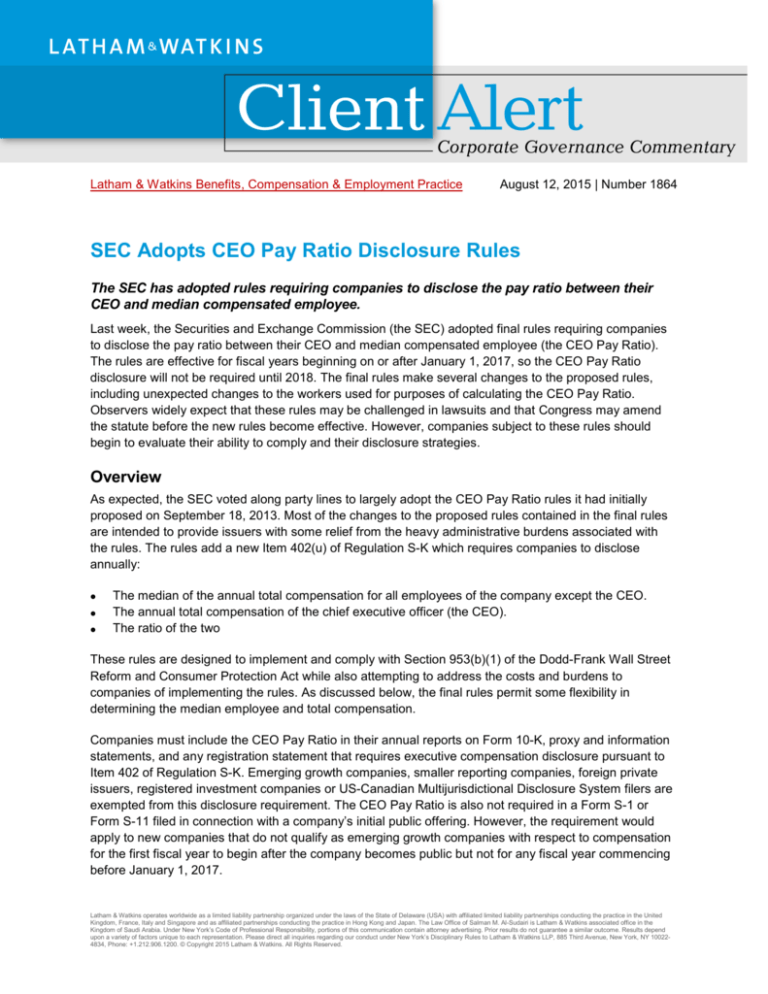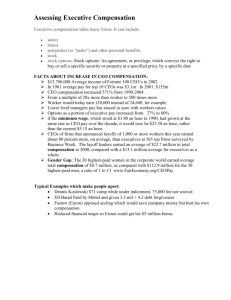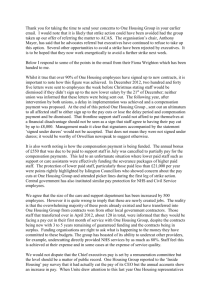
Latham & Watkins Benefits, Compensation & Employment Practice
August 12, 2015 | Number 1864
SEC Adopts CEO Pay Ratio Disclosure Rules
The SEC has adopted rules requiring companies to disclose the pay ratio between their
CEO and median compensated employee.
Last week, the Securities and Exchange Commission (the SEC) adopted final rules requiring companies
to disclose the pay ratio between their CEO and median compensated employee (the CEO Pay Ratio).
The rules are effective for fiscal years beginning on or after January 1, 2017, so the CEO Pay Ratio
disclosure will not be required until 2018. The final rules make several changes to the proposed rules,
including unexpected changes to the workers used for purposes of calculating the CEO Pay Ratio.
Observers widely expect that these rules may be challenged in lawsuits and that Congress may amend
the statute before the new rules become effective. However, companies subject to these rules should
begin to evaluate their ability to comply and their disclosure strategies.
Overview
As expected, the SEC voted along party lines to largely adopt the CEO Pay Ratio rules it had initially
proposed on September 18, 2013. Most of the changes to the proposed rules contained in the final rules
are intended to provide issuers with some relief from the heavy administrative burdens associated with
the rules. The rules add a new Item 402(u) of Regulation S-K which requires companies to disclose
annually:
•
•
•
The median of the annual total compensation for all employees of the company except the CEO.
The annual total compensation of the chief executive officer (the CEO).
The ratio of the two
These rules are designed to implement and comply with Section 953(b)(1) of the Dodd-Frank Wall Street
Reform and Consumer Protection Act while also attempting to address the costs and burdens to
companies of implementing the rules. As discussed below, the final rules permit some flexibility in
determining the median employee and total compensation.
Companies must include the CEO Pay Ratio in their annual reports on Form 10-K, proxy and information
statements, and any registration statement that requires executive compensation disclosure pursuant to
Item 402 of Regulation S-K. Emerging growth companies, smaller reporting companies, foreign private
issuers, registered investment companies or US-Canadian Multijurisdictional Disclosure System filers are
exempted from this disclosure requirement. The CEO Pay Ratio is also not required in a Form S-1 or
Form S-11 filed in connection with a company’s initial public offering. However, the requirement would
apply to new companies that do not qualify as emerging growth companies with respect to compensation
for the first fiscal year to begin after the company becomes public but not for any fiscal year commencing
before January 1, 2017.
Latham & Watkins operates worldwide as a limited liability partnership organized under the laws of the State of Delaware (USA) with affiliated limited liability partnerships conducting the practice in the United
Kingdom, France, Italy and Singapore and as affiliated partnerships conducting the practice in Hong Kong and Japan. The Law Office of Salman M. Al-Sudairi is Latham & Watkins associated office in the
Kingdom of Saudi Arabia. Under New York’s Code of Professional Responsibility, portions of this communication contain attorney advertising. Prior results do not guarantee a similar outcome. Results depend
upon a variety of factors unique to each representation. Please direct all inquiries regarding our conduct under New York’s Disciplinary Rules to Latham & Watkins LLP, 885 Third Avenue, New York, NY 100224834, Phone: +1.212.906.1200. © Copyright 2015 Latham & Watkins. All Rights Reserved.
As has been widely reported since the enactment of the Dodd-Frank Act, the requirement that US public
companies disclose the CEO Pay Ratio has been hotly debated and it is clear that the adoption of the
final rules will not end the debate. It is also clear that much can happen to change the rules before they
require disclosures to be made in 2018 proxies. The extension of the application and disclosure
compliance dates by one year in the final rules has taken some of the pressure off companies subject to
the rules. However, companies should now begin to consider what it would take for them to gather the
necessary information to make the CEO Pay Ratio calculations for 2017. Companies should also start to
consider whether in 2018 it may make sense to disclose more than the minimum required disclosure in
order to provide additional context in view of their particular employee, public and investor relations
issues.
Key Determinations
The CEO Pay Ratio rules’ key features and action items are as follows.
Determine “all employees.”
For purposes of calculating the pay ratio, companies are required to determine the annual total
compensation of “all employees” (other than the CEO) of the registrant and its consolidated subsidiaries.
Subject to the exceptions listed below, this captures all employees employed as of a date selected by the
company within the last three months of the company’s last completed fiscal year, including all worldwide
full-time, part-time, seasonal or temporary workers.
Under the proposed rules, independent contractors and “leased” workers who are employed by a third
party were excluded from the determination of “all employees” for purposes of the pay ratio calculation.
Under the final rules, however, it is unclear whether or not independent contractors who are engaged
directly and not through third parties are excluded. The SEC’s press release implies that all independent
contractors should be excluded, but Commissioner Piwowar in his Additional Dissenting Comments on
Pay Ratio Disclosure indicates that independent contractors may only be excluded if they are employed
by an unaffiliated third party.
Item 402(u)(3) of Regulation S-K provides in relevant part:
“The definition of employee or employee of the registrant does not include those workers who are
employed, and whose compensation is determined, by an unaffiliated third party but who provide
services to the registrant or its consolidated subsidiaries as independent contractors or ‘leased’
workers.”
This language — including the use of the word “workers” instead of limiting the definition to employees —
could be interpreted to mean that only independent contractors whose compensation is determined by a
third party, and not independent contractors who contract directly with the registrant, may be excluded.
This interpretation would impose significant additional costs and administrative burdens on many
companies that directly contract with consultants and other independent contractors. But it is not clear
whether this reflects the SEC’s interpretation. We and others have asked the SEC for additional
guidance, but as of the date of this Client Alert the SEC has declined to provide additional clarity.
The final rules also exclude employees of joint ventures and unconsolidated subsidiaries.
Companies may also exclude:
Latham & Watkins
August 12, 2015 | Number 1864 | Page 2
A. Non-U.S. employees in a particular jurisdiction where foreign data privacy laws or regulations make
the company unable to include the employees in such jurisdiction. If a company excludes any nonU.S. employees in a particular jurisdiction under this exemption, it must exclude all non-U.S.
employees in that jurisdiction. The company must also obtain a legal opinion from counsel as to the
inability of the company to obtain or process the information necessary for including employees in
such jurisdiction, including the company’s inability to obtain an exemption or other relief under any
governing laws or regulations. This legal opinion must be filed as an exhibit with the filing in which the
CEO Pay Ratio is disclosed.
B. Non-US employees, if these employees account for 5% or less of the company’s total worldwide
employees. If a company relies on this exemption to exclude any non-US employees, the company
must exclude all of them.
C. In addition, if a company’s non-US employees exceed 5% of the company’s total worldwide
employees (such that the exemption under (B) above is not available), the company may exclude up
to 5% of its total employees who are non-US employees. If the company excludes any non-US
employees in a particular jurisdiction, the company must exclude all non-US employees in that
jurisdiction. In addition, in calculating the number of non-US employees that may be excluded under
this de minimis exemption, the company must count any non-US employees exempted under the
data privacy exemption (under (A) above) against the availability. Thus, if the number of employees
excluded under the data privacy exemption equals or exceeds 5% of the company’s total employees,
this exemption will not be available.
D. Any persons that became a company’s employees as a result of a business combination or
acquisition for the fiscal year in which the transaction occurred. However, these individuals would
need to be considered for subsequent years.
If a company omits any employee based on the above exclusions, it will need provide certain disclosures
explaining that such employees have been omitted from the pay ratio calculations, including, among other
information, the approximate number of employees omitted. To the extent that a company excludes nonUS employees under these exceptions, then it must also disclose the jurisdictions where such employees
are located. If employees are excluded under the de minimis exception, then the company must also
disclose the total number of US and non-US employees (without regard to any exclusions) and the total
number of US and non-US employees used for the de minimis calculation.
Find the “median employee.”
To help mitigate compliance costs, the final rules allow companies to identify the median employee once
every three years unless there has been a change in its employee population or employee compensation
arrangements that the company reasonably believes would result in a significant change in the pay ratio
disclosure. Thus, absent one of these significant changes, the same median employee may be used for
three consecutive years.
The rules do not mandate any specific method for identifying the median employee. The median
employee may be identified using annual total compensation or any other compensation measure
consistently applied to all employees included in the calculation, such as information derived from tax or
payroll records (e.g., W-2 reportable wages). Also, in determining the employees from which the median
is identified, a company is permitted to use its employee population, statistical sampling or other
reasonable methods.
Latham & Watkins
August 12, 2015 | Number 1864 | Page 3
Companies may (but are not required to) annualize the compensation for all permanent employees (other
than those in temporary or seasonal positions) who were not employed for the entire fiscal year, such as
a new hire or an employee who took an unpaid leave of absence during the period. The rules do not
permit full-time equivalent adjustments for part-time employees, or annualizing adjustments for temporary
or seasonal employees. The rules also permit cost-of-living adjustments for the compensation of
employees in jurisdictions other than the jurisdiction in which the CEO resides, such that the
compensation is adjusted to the cost of living in the jurisdiction in which the CEO resides. A company that
uses cost-of-living adjustments to present the pay ratio must also disclose the median employee’s annual
total compensation and pay ratio without the cost-of-living adjustments.
The methodology and any material assumptions, adjustments or estimates used to identify the median
employee must be disclosed, although companies need not disclose technical analyses or formulas. If a
company changes its methodology or its material assumptions, adjustments, or estimates from those
used in the prior fiscal year, and if the effects of any such change are significant, the company must
briefly describe the change and the reasons for the change.
Determine the median employee’s total compensation per Item 402 of Regulation S-K.
Once the median employee is identified, the company then needs to calculate that one median
employee’s annual “total compensation” in accordance with Item 402 of Regulation S-K to determine the
pay ratio. Companies may use reasonable estimates when calculating any elements of the annual total
compensation for the median employee. In addition, companies may, at their discretion, include personal
benefits that aggregate less than $10,000 and compensation under non-discriminatory benefit plans in
calculating the annual total compensation of the median employee — as long as these items are also
included in calculating the CEO’s annual total compensation.
Calculate the CEO’s Total Compensation.
A company will normally use the total compensation figure of the CEO from the Summary Compensation
Table as reported in the proxy. However, if a company has more than one CEO during the prior fiscal
year, the final rules permit the company to either (i) combine the total compensation of each CEO or (ii)
annualize the compensation of the person serving as CEO as of the date the company selected to
determine the median employee.
Disclose the CEO Pay Ratio.
The CEO Pay Ratio must be expressed as a ratio in which the median of the annual total compensation
of all employees is equal to one (e.g., “1 to 200”) or, alternatively, expressed in narrative form in terms of
the multiple that the CEO total compensation amount bears to the median of the annual total
compensation amount of all employees (e.g., “the CEO’s annual total compensation is 200 times that of
the median of the annual total compensation of all employees”). Companies are permitted to supplement
required disclosure with a narrative discussion or additional ratios. Any additional information has to be
clearly identified, not misleading and not presented with greater prominence than the required ratio.
Other Considerations
Currently, US public companies are required to discuss any internal pay equity policies they may have in
the Compensation Discussion & Analysis section of their proxy statements. Companies should review
that disclosure in light of the CEO Patio Ratio disclosure and assess whether or not further detail should
be provided or other revisions should be made.
Latham & Watkins
August 12, 2015 | Number 1864 | Page 4
If you have questions about this Client Alert, please contact one of the authors listed below or the Latham
lawyer with whom you normally consult:
James D. C. Barrall
jim.barrall@lw.com
+1.213.891.8342
Los Angeles
Bradd L. Williamson
bradd.williamson@lw.com
+1.212.906.1826
New York
Robin Struve
robin.struve@lw.com
+1.312.876.7626
Chicago/Boston
Maj Vaseghi
maj.vaseghi@lw.com
+1.650.470.4852
Silicon Valley
Ashley E. Wagner
ashley.wagner@lw.com
+1.650.470.4873
Silicon Valley
You Might Also Be Interested In
How to Navigate the SEC’s Proposed Mandate on Clawbacks
Director Compensation: Is This the Calma Before a Storm or Just a Summer Squall? A Handful
of Forecasts
New SEC Proposed Rules on Pay versus Performance
Guide to Financial Statement Requirements in US Securities Offerings by US Issuers
Client Alert is published by Latham & Watkins as a news reporting service to clients and other friends.
The information contained in this publication should not be construed as legal advice. Should further
analysis or explanation of the subject matter be required, please contact the lawyer with whom you
normally consult. The invitation to contact is not a solicitation for legal work under the laws of any
jurisdiction in which Latham lawyers are not authorized to practice. A complete list of Latham’s Client
Alerts can be found at www.lw.com. If you wish to update your contact details or customize the
information you receive from Latham & Watkins, visit http://events.lw.com/reaction/subscriptionpage.html
to subscribe to the firm’s global client mailings program.
Latham & Watkins
August 12, 2015 | Number 1864 | Page 5




